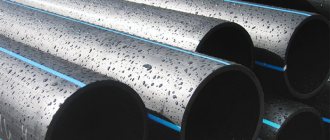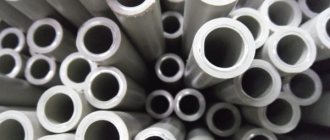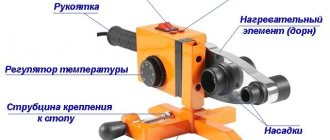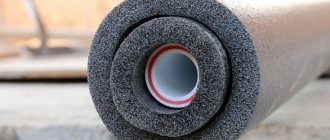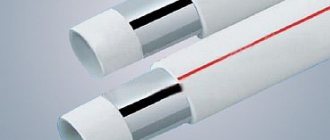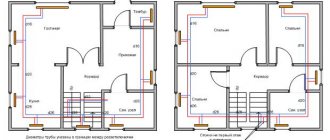Plastic pipes can be found in almost every private house or apartment - they are universal, easy to install and maintain, and durable. But with unprofessional installation or exposure to external factors, there is a high probability that the plastic pipe will begin to leak at the junction. It is important to quickly eliminate the leak in order to avoid an emergency situation, flooding your bathroom and neighbors on the floor below. How to do this yourself before the plumber arrives?
- Why does a plastic pipe leak at the junction?
- What to do if a plastic pipe leaks at the junction - emergency help
- How to repair a leak in a plastic pipe - step-by-step instructions
Why does a plastic pipe leak at the junction?
Plastic pipelines quite often lose their tightness, which leads to water leaks. The appearance of drops at the joints is the first alarm signal, indicating that it is time to check the joints and eliminate leaks. There are several reasons causing this problem:
- violation of soldering technology during installation of the product when the technician chose the wrong temperature mode;
- loosening the nuts - you can simply tighten the clamp with your own hands, without resorting to the help of specialists;
- poor pressing of the fitting - it will not be possible to use it a second time for safety reasons; the fitting on the plastic pipe must be replaced;
- uneven joint when using sliding structures.
Often the causes of leaks are due to technological violations, the use of unreliable materials and components, which affects durability.
Fitting for plastic pipes
What to do if a plastic pipe leaks at the junction - emergency help
If you don’t know how to fix a leak in a plastic pipe or have never dealt with plumbing work, it’s better to entrust this task to specialists. Before the plumber arrives, you should turn off the water supply to avoid flooding your neighbors. It is possible to localize both a separate section and the entire system, depending on the characteristics of communications.
Clamp clamps will help you fix the accident yourself - this is the simplest and most proven way to temporarily solve the problem. To work, take a screw clamp and a small piece of plastic, clamping the place of depressurization. By the way, preliminary turning off the water for such repairs is not required, but the fastening will not last long - over time its components weaken.
Clamps for plastic pipes
How to seal a sewer pipe if a leak has formed: tips and tricks
How to seal a sewer pipe if a leak has formed: tips and tricks
Leaks in the sewerage system happen quite often, so no one is immune from this unpleasant situation. Therefore, every home handyman should know how to seal a sewer pipe to eliminate the accident. Work should begin by identifying the location of the leak. And the method of eliminating it will be chosen taking into account the nature of the damage and the material from which the pipes are made.
The appearance of a sewer smell in the apartment may indicate that a leak has formed somewhere in the pipeline. In this case, it is necessary to inspect the pipes and their connections with fittings in order to promptly identify the location of the problem.
To eliminate the leak, you will need to choose the most suitable repair method. In this case, the sealing of sewer pipes is carried out taking into account the material from which they are made, as well as the nature of the pipeline defect.
Causes of leaks
Leaks can occur at pipe joints or when the wall of the pipe itself is damaged. The reasons that caused the emergency situation may be different. First of all:
Violations that were committed during the installation of the pipeline.
Defects made during the production of pipes or fittings.
Improper operation of the sewer system.
Repairing a leak caused by a damaged pipe
If the cause of the leak is complete wear of the pipe, then, of course, the best repair method is to replace the worn section of the pipeline. But it happens that it is impossible to carry out major repairs at a given time, or a leak has formed on a quite strong pipe as a result of mechanical damage. In this case, insulation of sewer pipes is carried out using one of the methods proposed below.
Methods for sealing a fistula on a pipe
If the hole is small, then to eliminate it you can use a plug in the form of a short wooden wedge.
Advice! It is not recommended to use long plugs, as they will obstruct the flow of wastewater, and this can lead to blockage.
The second option for fixing a small leak is to wrap the pipe with a bandage or gauze, which is then soaked in epoxy resin.
You can also wrap a wide rubber band around the leak area, wrapping a few tight turns of wire around the improvised gasket on top.
Advice! All of the described methods for eliminating leaks are temporary measures that allow you to delay the need to replace the pipe for some time.
More reliable waterproofing of sewer pipes is achieved by installing a rubber gasket in place of the fistula and tightening it with a clamp or repair coupling.
Crack in sewer pipe
It happens that a defect in a sewer pipe is not a small hole, but a fairly long crack. How to close a sewer pipe with such damage?
First, it is worth understanding what caused the cracks to form. As a rule, such damage most often appears on the exhaust part of the riser, and the reason for this is the formation of an ice plug in the pipe.
Cracks in a pipe can be continuous or superficial. So, if a crack is visible on the surface, but the smell of sewage is not felt, then most likely the damage is superficial. The appearance of moisture in the places of such cracks does not indicate a leak, but that condensation is accumulating on the pipe.
Sealant for sewer pipes is ideal for repairing surface cracks. The defect is eliminated as follows:
The crack is carefully widened so that the sealant can penetrate deeper.
The surface of the crack is degreased and dried well.
Apply sealant to the damage and allow it to dry.
Advice! To avoid future cracks in the risers due to the formation of ice plugs, it is necessary to insulate the pipe.
READ ALSO: Choosing a welding machine for polyethylene pipes: tips, welding features, rating of models
How to cover a sewer pipe when through cracks appear? Such serious damage to the sealing with a two-part adhesive composition, which is often called “cold welding”. The adhesive composition is prepared according to the instructions, applied to a degreased and dried surface. After the composition has completely hardened, the surface can be sanded, so the repairs performed will not affect the appearance of the pipe.
Eliminating leaks at pipe joints
Much more often, a leak in the sewer system occurs at the junction of pipes. The reason for this situation may be errors during installation or wear and tear of the pipeline. In any case, sealing the sewer pipes will be required to eliminate the leak. This work is quite serious and labor-intensive, especially if leaks are detected in the external pipeline.
Advice! The volume of work on re-sealing is comparable to the volume of work on installing a pipeline, so it is important to immediately make connections according to all the rules at the stage of pipeline construction.
Let's consider how to seal sewer pipes to completely eliminate the leak.
Pipe Sealing Tape
This is a fairly new and very easy-to-use material, created specifically for sealing pipe joints. The advantage of this material is its ease of use and high efficiency. The basis of the sealing tape is polyethylene.
Thanks to the qualities of this polymer, the tapes have high strength and elasticity characteristics. They can be used to seal pipelines of any type. Tapes can be used to seal not only the joints between pipes, but also the places of tappings, installation of plugs and bends.
Sealing the joint when using tapes proceeds according to the following plan:
Surfaces are cleaned of dust and dirt and dried well.
The tape is applied to the joint, providing it with constant tension.
Advice! It is important that when applying the tape, no folds or wrinkles form.
The tape is wound onto the pipe in a spiral, and the layers should form an overlap with a height of half the width of the tape. If applied correctly, the surface of the pipe will be covered with two layers of tape.
When using sealing tape on open sections of a pipeline, a protective coating is applied over it, since the film is destroyed by UV radiation.
Silicone based sealants
Sealant for sewer pipes is often used to eliminate leaks. The basis of this material is silicone, a substance that can provide an excellent degree of sealing.
Sealants have good adhesion to various surfaces, and there is no need to use a primer. It is recommended to use this material for sealing joints on pipelines made of metal and various polymers.
Classification of sealants is carried out depending on the type of hardener used, they are distinguished:
Acid sealants. This type of material is affordable, but is not recommended for processing materials that can react with acids.
Sealants neutral volumetric wall stickers. This is an almost universal material that can be used with any materials.
Advice! As a rule, you must use a nail gun to apply sealant. When you press the handle of this tool, an even strip of sealant is squeezed out of the tube. If you don’t have a mounting gun, you can use the simplest hammer by inserting its handle into the tube. However, in this case it will be much more difficult to achieve uniform extrusion of the sealant.
Other materials for sealing joints
Sealing pipe joints with sulfur
Technical sulfur. This material was widely used in the past for sealing sockets in cast iron pipelines. The sulfur is pre-crushed to a powder, poured into the bell and heated to the melting point. It must be said that at present this method of sealing is practically not used, since inhaling sulfur vapors released when it is heated during installation is unsafe for health.
Portland cement. This material is also used in the assembly of cast iron pipelines.
Hemp or jute ropes impregnated with resin. This type of joint sealing is used when assembling socketed cast iron or asbestos-cement pipelines.
Asphalt mastic prepared on the basis of bitumen. This lubricant for sewer pipes is recommended for use when installing ceramic pipes.
Epoxy resin. This material is most often used when assembling pipelines with your own hands and when making repairs to fix leaks.
How is a socket joint sealed?
Sealing a socket connection
When installing plastic pipes, the connection is sealed by installing a rubber O-ring. When using cast iron bell pipes, different methods are used.
The traditional way of making a connection is to fill the socket two-thirds of the way up with a strand of hemp impregnated with resin. The remaining height of the socket is filled with Portland cement.
To ensure better sealing of cast iron sewer pipe joints and require less labor, it is recommended to use self-expanding waterproof mixtures instead of conventional cement. Such a solution, placed in a socket, quickly hardens, expanding and filling all the free space.
The tightness of the connections is one of the most important conditions for the effective operation of the sewerage system. Therefore, special attention must be paid to this part of the work both at the installation stage and during pipeline repairs.
READ ALSO: How to fix a leak in a plastic pipe: how to fix it if the joint is leaking, leaking at the junction of polypropylene pipes because they burst
How to repair a leak in a plastic pipe - step-by-step instructions
When a plastic pipe leaks at the junction, it is important to solve this problem in a timely and prompt manner using one of the proposed methods:
- Cold welding - turn off the water supply, prepare the component for sealing the crack, knead it, apply it to the damaged area, and then wait until it hardens;
- Glue bandage - take two clamps and a piece of material soaked in glue, install it in the area of the leak, tighten the screws. The method is not recommended for pipes under pressure;
- Sealing tape - it is wound around the joint in several layers, making sure that the material fits as tightly as possible;
- Sealant - degrease the damaged area, and then apply a special compound. It can be neutral, acidic or silicone, the latter is considered universal.
In the event of a water pipe leak hidden under the finishing, it will have to be partially dismantled; there is no other way to get to the scene of the accident.
Today it is not at all uncommon for a plastic pipe to leak at the junction in apartments.
How to repair the damage? Use clamps, sealant or cold welding, but keep in mind that these methods are only a temporary solution; often a complete replacement of the damaged area is required, eliminating future flooding. Although this involves additional costs, it is as reliable as possible. Back to list Share: Send link
Emergency repair without draining coolant
Possible if the water does not stream, but simply drips.
1. Crimp with a screw clamp without using glue. Let's take advantage of some of the elasticity of polypropylene. A crimp clamp is applied to the coupling from which it is leaking. After tightening the screw, the leak will decrease and possibly disappear altogether. You can leave it like this until the end of the heating season. But when the temperature of the coolant changes, polypropylene contracts and expands. You will have to constantly monitor the joint.
READ ALSO: At what temperature does a polyethylene pipe melt?
Therefore, it would be more correct to additionally seal the connection using an adhesive.
2. Application of “cold welding”. Most of these compounds can be used in damp environments.
The main thing is that the binding force of the glue can withstand the pressure of flowing water. This is where preventive crimping of the coupling using a clamp will help. Simply covering up the leak is not enough. After several temperature changes, micro gaps will appear between the glue and the pipe, and the flow will resume. For reliability, it is necessary to install another supporting coupling opposite the defective joint, let’s call it a repair coupling. It is cut from standard connecting fittings. To put it on the pipe, we make a longitudinal cut (cut).
We clean the pipe with sandpaper, degrease it, and dry the leak area if possible.
We put a repair coupling on the pipe, prepare “cold welding” glue, and cover the leak area. We move the coupling to the joint, fix it with a second clamp.
In this case, the glue will compact between the couplings and fix the leak. Due to the mixing of “cold welding” with water, the appearance is not very aesthetic. This does not affect the strength (the glue is designed for such use).
The goal has been achieved: the leak has been eliminated. But this solution is temporary; the epoxy glue will gradually crack.

